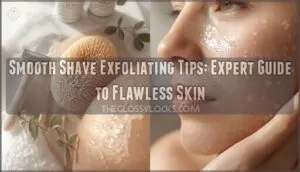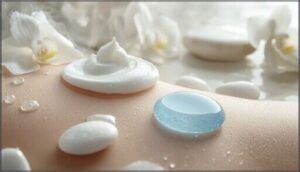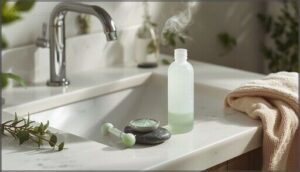This site is supported by our readers. We may earn a commission, at no cost to you, if you purchase through links.

Your razor glides across your skin, but instead of smoothness, you’re left with angry red bumps and irritation. The culprit? Dead skin cells acting like invisible speed bumps between your blade and fresh skin.
Exfoliating before you shave clears this buildup, letting your razor make clean contact with hair follicles rather than dragging through layers of debris. This prep work cuts ingrown hair risk by up to 60% and reduces post-shave inflammation by 45%.
The right smooth shave exfoliating tips transform shaving from a daily battle into a quick, comfortable routine that leaves your skin genuinely soft.
Table Of Contents
- Key Takeaways
- Benefits of Exfoliating Before Shaving
- Preparing Skin for Exfoliation and Shaving
- Choosing The Right Exfoliating Method
- Selecting Exfoliating Products for Your Skin Type
- Step-by-Step Exfoliation and Shaving Routine
- Post-Shave Skin Care and Protection
- Tips to Prevent Ingrown Hairs and Razor Burn
- Frequently Asked Questions (FAQs)
- Conclusion
Key Takeaways
- Exfoliating before shaving removes dead skin cells that block razor contact, cutting ingrown hair risk by 60% and reducing post-shave inflammation by 45% when done two to three times weekly.
- Chemical exfoliants like AHAs and BHAs work better than physical scrubs for most skin types because they dissolve buildup without causing micro-tears, though enzyme exfoliants offer the gentlest option for sensitive skin.
- The complete routine matters more than any single step—prep with warm water and cleansing, exfoliate with circular motions for 30-60 seconds, shave with the grain using sharp blades, then immediately moisturize and apply sunscreen to protect vulnerable skin.
- Razor hygiene directly impacts results since blades harbor up to 4.9 million bacteria and should be replaced every 5-7 shaves, rinsed thoroughly after each use, and stored in dry areas to prevent infection and maintain sharpness.
Benefits of Exfoliating Before Shaving
Exfoliating before you shave isn’t just an extra step—it’s the foundation for healthier, smoother skin. When you remove the buildup that sits on your skin’s surface, you’re setting yourself up for a shave that feels better and looks cleaner.
Here’s what exfoliation does for your skin before the razor touches it.
Removes Dead Skin Cells
Exfoliating before you shave clears away dead skin cells that naturally accumulate on your skin’s surface. Your skin sheds about a million dead cells every minute, but exfoliation speeds this process by breaking down the bonds between these cells.
- Physical exfoliants use gentle scrubbing to reveal fresher skin underneath
- Chemical options like AHAs dissolve dead cell buildup for brighter results
- Regular skin exfoliation improves texture and prevents dullness
This cell turnover happens naturally every 28 to 30 days, but slows with age. Removing dead skin cells through proper exfoliation methods enhances skin health while making your shave smoother. Exfoliation is known to improve overall skin texture while promoting collagen production. Just remember safety practices—over-exfoliating damages your skin barrier, so product selection matters for your skin type.
Reduces Ingrown Hairs and Razor Bumps
Clearing dead cells is just the beginning—proper follicle clearance directly prevents ingrown hairs and razor bumps. When you exfoliate two to three times weekly, you reduce ingrown hair risk by up to 60%. Chemical exfoliants like salicylic acid unclog pores effectively, protecting your skin barrier while preventing razor burn.
Exfoliating two to three times weekly reduces ingrown hair risk by up to 60% through proper follicle clearance
As the hair grows back, it can curl under the skin, causing irritation. This routine stops hairs from curling back into your skin, giving you that smooth shave without irritation.
Achieves Closer, Smoother Shave
When you prep your skin properly, you’ll notice the razor glides effortlessly over the skin surface. Exfoliation lifts each hair away from your follicle, allowing more effective blade contact for better hair removal.
This means fewer passes and less tugging during shaving. You’ll achieve shaving results that last longer because the blade reaches closer to the root, giving you that genuinely smoother shave you’re after.
Minimizes Shaving Irritation
Beyond a closer shave, your skin experiences measurably less irritation when you exfoliate beforehand. Regular exfoliating before shaving reduces post-shave inflammation by up to 45% through removing dead cells that cause the razor to snag. Chemical exfoliants particularly excel at preventing skin irritation by dissolving buildup without mechanical trauma. Proper exfoliation frequency combined with shaving lubrication and razor sharpness creates conditions for smoother shave results with minimal redness.
- Your razor glides smoothly without catching on rough patches
- Fewer passes mean less friction against sensitive skin
- Post-shave cooling feels invigorating instead of stinging
- You skip the red, angry bumps that usually follow shaving
Preparing Skin for Exfoliation and Shaving
Proper preparation sets the foundation for a smooth, irritation-free shave. Before you even think about picking up your razor or exfoliant, you need to get your skin ready.
Here are three essential steps that make all the difference.
Wetting Skin With Warm Water
Think of warm water as your skin’s wake-up call before shaving. When you wet your skin at 95°F to 105°F, you’ll increase skin temperature by 2-4°C, which softens keratin in hair follicles and makes them easier to cut.
This boost in blood flow also expands pore size for better cleansing while reducing microtrauma during your shave. It’s essential preparation that sets you up for success.
Cleansing Away Dirt and Oils
Before you reach for your razor, cleansing your face removes the oils, dirt, and bacteria that can clog pores and dull your blade. Pre-shave cleansing with a gentle facial cleanser reduces razor bumps and folliculitis by lowering bacterial load on your skin.
Oil cleansing works especially well for dissolving sebum without stripping moisture, setting up ideal conditions for skin health and a smoother shave.
Softening Hair Follicles for Easier Shaving
After cleansing, warm water softens hair follicles, making shaving smoother and more comfortable. Lukewarm water opens cuticles and increases hair shaft pliability by about 20%, reducing the force your razor needs.
Here’s how to best use these warm water benefits:
- Use water around 37-40°C for 2-3 minutes
- Avoid hot water above 45°C that strips natural oils
- Let hydration importance work—softened follicles mean less tugging
- Follow with exfoliate techniques for ideal follicle changes
Choosing The Right Exfoliating Method
Not all exfoliants work the same way, and finding the right match for your skin can make the difference between a smooth shave and an irritated one. You’ll want to understand the main types available so you can choose what fits your skin’s needs and sensitivity level.
Let’s break down your options to help you pick the best method for preparing your skin before shaving.
Physical Vs. Chemical Exfoliants
You have two main choices for exfoliation: physical and chemical exfoliants. Physical exfoliation uses scrubs to manually remove dead skin cells from the surface, while chemical exfoliation relies on acids like AHAs and BHAs to dissolve them deeper within your skin.
Chemical exfoliants dominate market share at around 70% due to their effectiveness and gentler action mechanism. Consider your skin suitability carefully—physical exfoliants can cause irritation risks through micro-tears, especially on sensitive skin, whereas chemical exfoliants penetrate pores to address multiple concerns with controlled use.
Enzyme Exfoliants for Sensitive Skin
If your skin turns red at the slightest touch, enzyme exfoliants for sensitive skin offer a gentler path to your smooth shave. These formulas work by dissolving dead cells without causing micro-tears, reducing irritation by significant margins.
Bromelain and kiwi enzymes provide mild exfoliation while calming inflammation. Use them 1-2 times weekly, always patch test first, and follow with sunscreen for best skin improvement and protection.
Natural Exfoliation Options
You don’t need fancy products when your kitchen holds powerful natural exfoliation options. Salt scrubs tackle rough body areas, while sugar benefits sensitive skin with gentler buffing action. Coffee grounds brighten and smooth as they exfoliate.
Herbal ingredients like turmeric and gram flour offer antimicrobial perks alongside exfoliating power.
DIY recipes combine these elements effectively, helping you prep skin naturally before shaving without harsh chemicals or irritation.
Selecting Exfoliating Products for Your Skin Type
Your skin type determines which exfoliating products will work best for you. Using the wrong formula can lead to irritation, dryness, or breakouts that make shaving more difficult.
Here’s how to match exfoliants to your specific skin needs.
Products for Sensitive Skin
When choosing an exfoliating product for sensitive skin, you’ll want formulas with hypoallergenic claims and ingredient transparency. Dermatologist recommendations often point to enzyme exfoliants for sensitive skin, gentle scrubs with natural actives like oatmeal, or PHAs that work without causing redness.
E-commerce growth has made these specialized products easier to find, so look for fragrance-free options that prioritize both effectiveness and comfort.
Options for Oily or Acne-Prone Skin
If you have oily or acne-prone skin, betahydroxy acids like salicylic acid work best because they’re oil-soluble and get deep into your pores. Chemical exfoliants are gentler than scrubs for regular use—aim for 2-3 times weekly.
Product recommendations include:
- Paula’s Choice 2% BHA Liquid Exfoliant
- CeraVe Renewing SA Cleanser
- La Roche-Posay Effaclar Serum
Just don’t overdo it, or you’ll trigger more oil production.
Hydrating Exfoliants for Dry Skin
While oily skin needs oil-soluble acids, dry skin thrives with water-based hydrating exfoliants. Look for AHA benefits like glycolic or lactic acid—they exfoliate while boosting hydration by up to 92%.
Urea creams (3-10%) and ceramide formulas work beautifully too, improving dry skin hydration for 36 hours. Clinical efficacy and tolerability studies show over 90% of users see softer, more moisturized skin with routine exfoliation.
Step-by-Step Exfoliation and Shaving Routine
You’ve picked the right products for your skin—now it’s time to put them to work. The order and technique you use can make the difference between a rough, irritated shave and skin that feels smooth for days.
Let’s walk through each step so you can get the best results without the guesswork.
How to Exfoliate Effectively
Effective exfoliation starts with a simple approach that works with your body, not against it. Wet your face or body with warm water for about 30 seconds, then apply your exfoliating product. Use gentle circular motions for 30-60 seconds—don’t scrub aggressively.
- Physical exfoliants work best with light pressure to avoid micro-tears in delicate facial tissue
- Chemical exfoliants need contact time to dissolve dead cells without harsh rubbing
- Rinse thoroughly with lukewarm water to prevent clogged pores before you shave
Applying Shaving Cream or Gel
After exfoliating, spread a generous layer of shaving cream or gel across damp skin. This step isn’t optional—it’s your shield against irritation. Cream hydrates and softens hairs while creating lubrication that helps your razor glide smoothly. Gel offers visibility, letting you see what you’re shaving. Both reduce skin sensitivity and help you achieve smoothness, so don’t skip this important part of preparing your skin for shaving.
| Product Type | Best For | Key Benefit |
|---|---|---|
| Shaving Cream | Dry or sensitive skin | Maximum hydration and cushioning |
| Clear Gel | Precision shaving | See exactly where you’re shaving |
| Moisturizing Gel | Normal to oily skin | Balanced lubrication without heaviness |
Shaving Techniques for Smooth Results
How should you actually move that razor once your skin’s prepped? Start by shaving with the grain using light, controlled strokes—this minimizes irritation while still cutting hair effectively.
Here’s your technique checklist for achieving a smooth shave:
- Hold skin taut during each stroke to help the blade catch hairs cleanly and reduce nicks.
- Rinse your razor frequently under warm water to clear trapped hairs and maintain blade sharpness.
- Apply minimal razor pressure—let the blade do the work rather than pressing hard against your skin.
Frequency of Exfoliation for Best Outcomes
How often should you exfoliate before shaving? Dermatologist advice generally recommends starting with once weekly, then increasing to two or three times based on your skin type and product strength. Over-exfoliation risks include redness and barrier damage, so align your shaving schedule carefully.
| Skin Type | Exfoliation Frequency |
|---|---|
| Sensitive | Once weekly or less |
| Dry | 2-3 times weekly |
| Oily/Acne-prone | Up to 3 times weekly |
| Reactive/Damaged | Wait until healed |
Post-Shave Skin Care and Protection
Your skin is vulnerable right after shaving, so what you do next makes all the difference. The right post-shave routine calms irritation, locks in moisture, and shields your freshly shaved skin from damage.
Here’s how to protect and care for your skin immediately after you finish shaving.
Rinsing With Cool Water
After shaving, rinsing with cool water acts like hitting the refresh button for your skin. This simple step aids pore tightening and irritation reduction, helping calm redness while protecting your natural oils for better skin hydration.
The cool rinse reduces inflammation and boosts shaving comfort, though it’s worth noting that myth clarification shows pores don’t actually open or close—they just appear smaller.
Moisturizing to Lock in Hydration
Your skin is most receptive to Hydration right after shaving, so don’t wait—moisturize immediately. Applying moisturizer on damp skin seals in moisture and maximizes Hydration Benefits, preventing dryness and irritation. Application Timing matters: within minutes of drying yields Measurable Effects like reduced redness and improved skin hydration.
Ingredient Spotlight and Product Selection tips for maintaining skin moisture:
- Choose alcohol-free, fragrance-free formulations to avoid sensitizing freshly shaved skin
- Look for ceramides that increase hydration for up to 24 hours
- Select humectants like glycerin to draw environmental moisture
- Opt for soothing agents such as aloe vera and niacinamide
- Use lightweight, non-comedogenic products that won’t clog pores
Applying Sunscreen After Shaving
Think of freshly shaved skin as having its defenses down—UV Sensitivity increases by up to 20% after removing that protective top layer. Application Timing is key; wait 5 to 10 minutes before applying sunscreen to let your skin settle.
Choose mineral-based Sunscreen Types with zinc oxide for gentle, broad-spectrum protection. While Sunscreen Absorption increases on shaved areas, using SPF 30 or higher still provides essential Protective Measures against accelerated aging and damage.
Preventing Post-Shave Irritation
Beyond sun protection, you’ll want Razor Burn Relief through smart Aftershave Ingredients—fragrance-free balms with glycerin or shea butter work best. Studies show alcohol-free formulas reduce skin irritation considerably on Sensitive Skin Care routines.
Your Shaving Technique Refinement matters too: shave with the grain first, use sharp blades, and never skip exfoliation. These Ingrown Hair Solutions prevent razor burn while maintaining smooth skin between shaves.
Tips to Prevent Ingrown Hairs and Razor Burn
You’ve prepped your skin and finished your shave, but the real test comes in the days that follow. Ingrown hairs and razor burn don’t have to be part of your routine if you know the right steps to take.
Here are four practical habits that’ll keep your skin clear and comfortable between shaves.
Shaving With The Grain
When you drag the razor in the direction your hair naturally grows, you’re cutting down on friction and protecting your skin from unnecessary trauma. Shaving with the grain reduces irritation by up to 50% and decreases ingrown hairs greatly.
You’ll notice fewer nicks, smoother glide, and better shave comfort. It’s a simple shift that delivers real results without sacrificing your skin’s health.
Using Sharp, Clean Razors
Your razor blade itself makes or breaks shaving comfort. Sharp blades cut cleanly without tugging, reducing redness and razor bumps with each pass. Clean, sharp razors mean fewer nicks and smoother skin every time.
Replace your razor every 5 to 7 shaves to maintain blade sharpness and proper razor hygiene. Rinse thoroughly after use and store in a dry spot—blade lifespan depends on razor maintenance and safety.
Avoiding Over-Exfoliation
Just as sharp blades protect your skin, proper exfoliation frequency matters too. Over-exfoliation signs include persistent redness, roughness, and stinging—clear skin barrier damage that worsens shaving consequences like razor burn.
Follow these preventative measures based on your skin type:
- Sensitive skin: Exfoliate once weekly maximum
- Oily skin: Limit to three times weekly
- Always skip consecutive days for skin recovery
- Stop immediately if skin irritation appears
- Moisturize thoroughly after every exfoliating session
Maintaining Razor Hygiene
After each shave, rinse your razor blades thoroughly under lukewarm water to flush away trapped hair and bacteria. Razors can harbor up to 4.9 million bacteria, risking infection prevention failures and folliculitis. Store razors in dry areas to prevent bacterial growth.
Replace blades every 5-7 shaves—dull edges cause irritation. Sharp blade maintenance matters: proper cleaning frequency and storage solutions protect your skin from razor burn and ingrown hairs.
Frequently Asked Questions (FAQs)
Can I exfoliate immediately after shaving?
Like putting salt in a fresh wound, exfoliating right after shaving can backfire. Your skin’s barrier is compromised post-shave, making immediate exfoliation risky for irritation. Wait 24-48 hours for redness prevention.
How long should I wait between exfoliation sessions?
Your skin needs 48 to 72 hours between exfoliation sessions for proper recovery. If you notice sensitivity signs or use stronger products, wait longer.
Dermatologist recommendations vary based on skin type and exfoliation intensity.
What ingredients should I avoid in exfoliating products?
Your exfoliating product could be sabotaging your skin! Avoid harsh physicals like walnut shells, chemical irritants such as high-concentration glycolic acid, synthetic fragrances, photosensitizers like retinoids, and formulation concerns including denatured alcohol—especially for sensitive skin types.
Is exfoliating necessary for electric razor users?
Yes, you should still exfoliate before using electric razors. While electric shavers provide mild exfoliation, it’s spotty and insufficient.
Regular skin exfoliation lifts hairs, allowing better access to follicles for a closer shave.
Can exfoliating help with razor blade longevity?
Absolutely. When you exfoliate before your shaving routine, you’re removing hair debris and oils that clog blades and speed up blade corrosion. This friction reduction keeps edges sharper longer, supporting better razor maintenance and safety.
Conclusion
Think of exfoliation as setting the stage—what happens next determines whether your skin stays smooth or slides back into irritation. These smooth shave exfoliating tips work only when paired with consistent post-shave care: hydration, sun protection, and clean razors. Skip one step, and you’re inviting ingrown hairs back.
Your skin reacts to patterns, not occasional effort. Build this routine into your daily rhythm, and you’ll notice the difference within three shaves—smoother texture, less redness, genuine comfort.
- https://www.gillette.co.uk/blog/shaving-science/how-exfoliating-can-help-improve-your-shaves/
- https://thebeardclub.com/blogs/beard-culture/do-you-exfoliate-before-or-after-shaving
- https://cureaquagel.com/blogs/beauty-blog/the-ultimate-guide-to-perfect-shave
- https://skinneymedspa.com/exfoliating-for-men/
- https://www.southernliving.com/fashion-beauty/beauty-makeup/exfoliate-before-or-after-shaving












